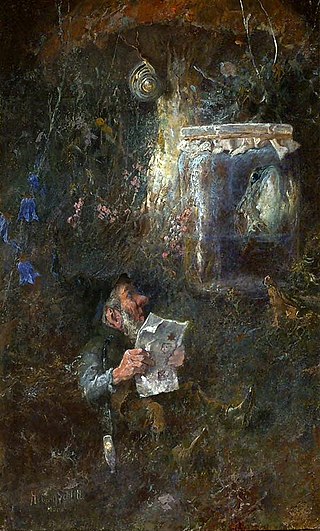
A gnome is a mythological creature and diminutive spirit in Renaissance magic and alchemy, first introduced by Paracelsus in the 16th century and later adopted by more recent authors including those of modern fantasy literature. Its characteristics have been reinterpreted to suit the needs of various story tellers, but it is typically said to be a small humanoid that lives underground.

Dr. Artemis Fowl II is the eponymous character of the Artemis Fowl series by Eoin Colfer.
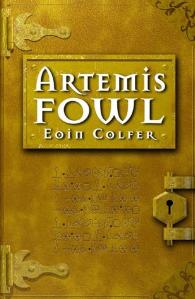
The Fowl Adventures is a series of eleven fantasy novels written by Irish author Eoin Colfer revolving around various members of the Fowl family. The first cycle, Artemis Fowl, follows elf Lower Elements Police Reconnaissance (LEPRecon) officer Holly Short as she faces the forces of criminal mastermind Artemis Fowl II, although later on in the cycle they become friends and Artemis Fowl II saves the world a few times. The second cycle received positive critical reception and generated huge sales. It has also originated graphic novel adaptations.

Artemis Fowl and the Eternity Code is the third book of Irish children's fiction author Eoin Colfer's Artemis Fowl series. It is preceded by Artemis Fowl: The Arctic Incident and followed by Artemis Fowl: The Opal Deception. The storyline follows Artemis Fowl and his companions as they struggle to recover the "C Cube", a supercomputer Artemis had constructed from fairy technology, when Jon Spiro manages to steal it. Critical response was generally favourable.

Captain Holly Short is a character in the Artemis Fowl novel series by Eoin Colfer.

Artemis Fowl is an Irish young adult fantasy novel written by Irish author Eoin Colfer. It is the first book in the Artemis Fowl series, the first cycle of The Fowl Adventures, followed by Artemis Fowl and the Arctic Incident. Described by its author as "Die Hard with fairies", the novel follows fairy LEP reconnaissance officer Holly Short after she is kidnapped by twelve-year-old criminal mastermind Artemis Fowl II for a large ransom of gold.
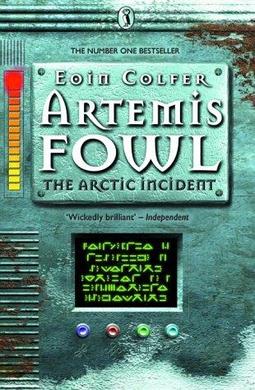
Artemis Fowl and the Arctic Incident, known in America as Artemis Fowl: The Arctic Incident, is a young adult and fantasy novel written by Irish author Eoin Colfer, published in 2002. It is the second book in the Artemis Fowl series, preceded by Artemis Fowl and followed by Artemis Fowl: The Eternity Code. It follows the adventures of the twelve-year-old criminal mastermind, Artemis Fowl II, as he thwarts a goblin rebellion and rescues his father, Artemis Fowl I. The third-person narration switches back and forth constantly, allowing the reader to understand more of what is going on. A New York Times bestseller, the novel was well received by critics, and reviews compared its quality and success to those of its predecessor.
Magical creatures are an aspect of the fictional Wizarding World contained in the Harry Potter series and connected media originally created by British author J. K. Rowling. Throughout the seven main books of the series, Harry and his friends encounter many of these creatures on their adventures in Hogwarts, the Forbidden Forest, or other locations throughout the Wizarding World. In addition, students learn to take care of creatures such as hippogriffs and unicorns in the Care of Magical Creatures class at Hogwarts. Rowling has also written Fantastic Beasts and Where to Find Them, a guide to the magical beasts found in the series, and based on the fictional textbook of the same name written by Newt Scamander and used by students at Hogwarts.

Artemis Fowl and the Opal Deception, known in America as Artemis Fowl: The Opal Deception, is a teen fantasy novel published in 2005, the 4th book in the Artemis Fowl series by the Irish author Eoin Colfer. Preceded by Artemis Fowl: The Eternity Code and followed by Artemis Fowl: The Lost Colony, it is centred on the brilliant pixie Opal Koboi's second try at rebellion and Artemis Fowl II and his fairy comrades' efforts to stop her. Critical reception was mixed, with some reviews praising the book and others deeming its writing poor and confusing.
Mulch Diggums is a fictional kleptomaniac dwarf from the Artemis Fowl series by Irish fiction author Eoin Colfer. He has been arrested numerous times by the LEP due to his criminal nature; stealing from humans and fairies is his speciality. An expert burglar, he is also infamous for his powerful and deadly flatulence, varieties including, the "torpedo", and the "cyclone". As a dwarf, he can tunnel underground using his unhinged jaws at high speeds. He even has his own tools to work in his favor. His beard hair act as antennae and he can pick up vibrations through walls and underground. Also, when they are pulled, they stiffen and form to work as keys and other useful items. When his spit dries it becomes rock solid and glows in the dark. It also contains a sedative. His dwarf rock polish is used to melt glass and metal. A side effect of his flatulence is the buildup of Methanobrevibacter smithii archaea, which prevents aeroembolism.
Gnommish is the "fairy language" used in the Artemis Fowl series by Eoin Colfer. It is not actually a language at all, but the English language encoded into a letter-substitution cipher where each symbol represents a letter. Lines of translatable Gnommish run along the bottoms of all the books in the series. However, in book one of the series, it is mentioned that one of the symbols was comparable to the Egyptian Anubis symbol. It is also mentioned that Gnommish is a mix of symbolic and alphabetic letters, running in spirals.
Mythic humanoids are mythological creatures that are part human, or that resemble humans through appearance or character. Each culture has different mythical creatures that come from many different origins. A major chunk of these creatures are humanoids. They are often able to talk and in many stories they guide the hero on their journey. They are said to come before the creation of gods and goddesses.
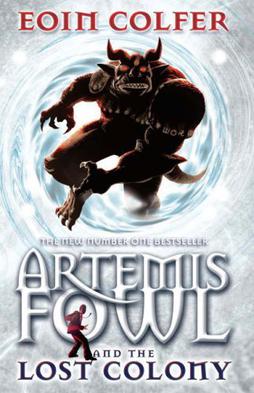
Artemis Fowl and the Lost Colony, known in America as Artemis Fowl: The Lost Colony, is the fifth book in the Artemis Fowl Series by Irish writer Eoin Colfer. The book, originally expected to be published in the UK and Ireland on 7 September 2006, was shipped to stores early. On 12 September of the same year, The Lost Colony became available in the US, and was released soon to other countries. It is followed by Artemis Fowl and the Time Paradox.

Artemis Fowl and the Time Paradox, known in America as Artemis Fowl: The Time Paradox, is the sixth book in the series Artemis Fowl by Irish writer Eoin Colfer. It was released in the U.S. on 5 July 2008, and on 7 August in the U.K. At 432 pages, it is the longest book in the series. In Colfer's video blogs, he mentioned the book, saying it may not be the last, but the last one for at least three years. It is followed by Artemis Fowl: The Atlantis Complex.
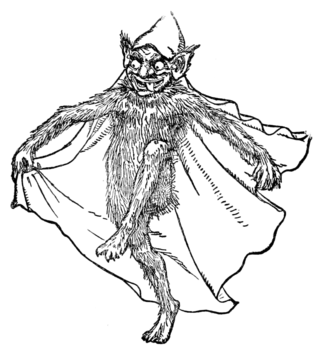
A goblin is a small, grotesque, monstrous creature that appears in the folklore of multiple European cultures. First attested in stories from the Middle Ages, they are ascribed conflicting abilities, temperaments, and appearances depending on the story and country of origin, ranging from mischievous household spirits to malicious, bestial thieves. They often have magical abilities similar to a fairy or demon, such as the ability to shapeshift.

Artemis Fowl and the Atlantis Complex, known in America as Artemis Fowl: The Atlantis Complex, is the seventh book in the Artemis Fowl series. It was published on 20 July 2010 in the United Kingdom and on 3 August 2010 in North America. It was followed by Artemis Fowl and the Last Guardian, which was confirmed to be the final book in the Artemis Fowl series.
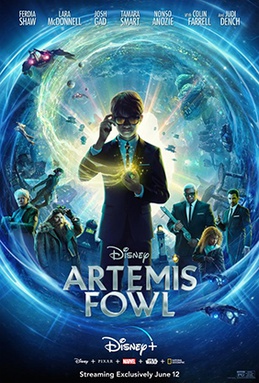
Artemis Fowl is a 2020 American science fantasy action adventure film based on the 2001 novel of the same name by Irish author Eoin Colfer. Directed by Kenneth Branagh, from a screenplay co-written by Conor McPherson and Hamish McColl, the film stars Ferdia Shaw, Lara McDonnell, Josh Gad, Tamara Smart, Nonso Anozie, Colin Farrell, and Judi Dench. It details the adventures of Artemis Fowl II, a twelve-year-old Irish prodigy who teams up with his faithful servant, as well as a dwarf and a fairy, in order to rescue his father, Artemis Fowl I, who has been kidnapped by another fairy looking to reclaim an item the Fowl family has stolen.









